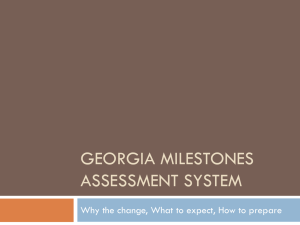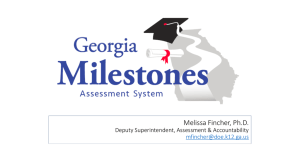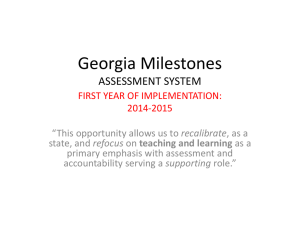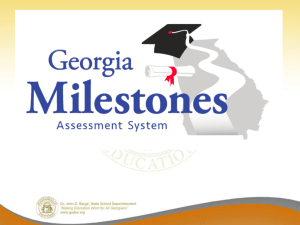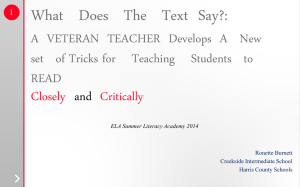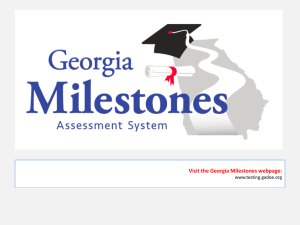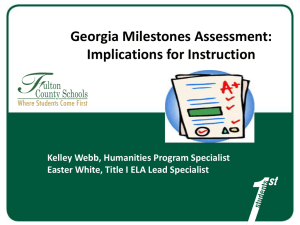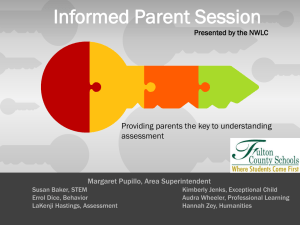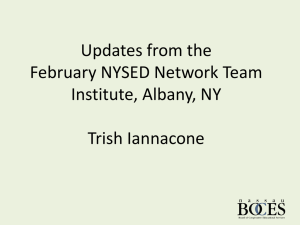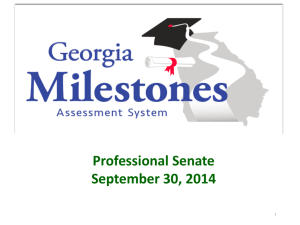Georgia Milestones and Its Instructional Implications
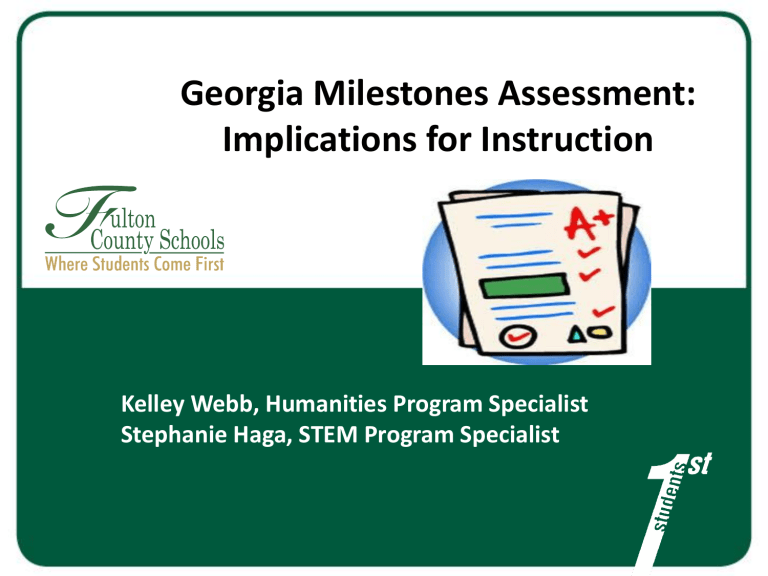
Georgia Milestones Assessment:
Implications for Instruction
Kelley Webb, Humanities Program Specialist
Stephanie Haga, STEM Program Specialist
What will the assessment look like in ELA?
• Write Score Sample Items (7th Grade)
• OAS Items (becoming GOFAR in SLDS)
• Engage NY: Just Released Test Items (Grades 3-8)
• Georgia DOE Assessment Guides (Grades 9-11)
Georgia Milestones
Consolidation of English Language Arts
• English Language Arts and reading will be combined and a writing component added for every grade level and course within the ELA assessment
• One overall ELA score and proficiency designation
• Reporting categories below the overall content area will be reported similar to the domains on the CRCT
• Cannot make proficiency claims at the lower level reporting categories
Georgia Milestones
Criterion Referenced and Norm Referenced
Items:
• students will receive 2 scores:
*criterion referenced score (55 total points)
*norm referenced score (20 total points)
• some norm-referenced items (10) will count as criterionreferenced items as well
Georgia Milestones
ELA
Criterion-Referenced
Total Number of Items: 44 / Total Number of Points: 55
Breakdown by Item Type:
– 40 Selected Response (worth 1 point each; 10 of which are aligned NRT )
– 2 Constructed Response (2 points each)
– 1 Constructed or Extended Response (worth 4 points ): literary prose
– 1 Extended Response (worth 7 points): informative/explanatory or argument/opinion
Norm-Referenced
– Total Number of Items: 20 (10 of which contribute to CR score)
Embedded Field Test
– Total field test items: 6
Total number of items taken by each student: 60
Georgia Milestones
Writing at Every Grade Level
All students will encounter a constructedresponse item allowing for narrative prose, in response to text , within the 1 st or
2 nd test section.
Writing at Every Grade Level
Extended Response Writing Section:
• Writing prompts will be informative/explanatory or opinion/argumentative depending on the grade level. Students could encounter either genre.
Georgia Milestones
Administration Times
Content
Area
ELA
Test Section Minimum
Time Per
Section
1 and 2
Maximum
Time Per
Section
60 minutes 70 minutes
ELA
(writing only)
3 70 minutes 90 minutes
Georgia Milestones
Scratch Paper
Blank scratch paper, including notebook paper, should be provided to students taking Milestones regardless of the administration mode:
ELA: Section 3 only
Mathematics: All sections
Write Score Example
Blueprint very similar to ELA Georgia
Milestones Assessment:
• selected response (multiple choice)
• constructed response
• extended response
Sample Assessment
Grade 3 Informational Task
Sample Assessment
Grade 7 Informational Task
What will students struggle with on the upcoming Georgia Milestones? Why?
What?
• complex texts
• text-dependent questions
• written response
• citing evidence
• analyzing and synthesizing information from two or more texts
• writing/typing online
Why?
• lack of student exposure to complex texts using close reading strategies
• lower level comprehension questions (Who? What? Where?)
• lack of teacher experience and training with literary analysis
• lack of teacher knowledge of Common Core standards
• lack of student experience with written response to text-dependent questions
How do we prepare our teachers and students for these assessments?
• provide teachers with sample assessment items
• model lessons that integrate reading and writing and cover multiple standards
• provide examples of complex texts (variety of literary, informational, and digital texts) and assist teachers with selection of these texts
• model close reading strategies, text analysis strategies, and textdependent questioning
• assist teachers with planning units and lessons that integrate reading and writing
Assessment Resources
Performance Based Assessments found in Fulton Connect
• Grades: 2, 5, 8, 9-10
• Genre: Argument/Opinion
• Types of assessment: constructed and extended response
• Location: Fulton Connect
• Purposes: both instructional and assessment
Formative Item Bank found in Fulton Connect
• Grades: all
• Types of assessment: selected and constructed response
• Location: Fulton Connect
• Purpose: assessment
• coming soon!!!
Assessment Resources
• Write Score Sample Items (3rd Grade)
• OAS Items (becoming GOFAR in SLDS)
• Journeys Performance Assessments (Reading Complex Text)
• Engage NY: Just Released Test Items
• Georgia Milestones Blueprints
How do we prepare our teachers and students for these assessments?
• provide teachers with sample assessment items
Model Lessons
• Reading and Writing Project Videos
Introduce a Text-Based Debate: Stray
Modeled Reading Lesson with Mary Ehrenworth: Pilgrims
• Sample lessons from Lucy Calkins’ Units of Study, Craft Lessons, Mentor
Texts
• Sample lessons from Write Score
• Elementary schools: CST professional development/Edmodo Group
How do we prepare our teachers and students for these assessments?
• model lessons that integrate reading and writing and cover multiple standards
How do we prepare students for the online writing assessments?
• provide opportunities to “write” on computers in and out of class
• keyboarding skills
• student and parent awareness
• access to computers
Opportunities to “write” on computers
• writing station during literacy stations at the computers (laptops, iPads, etc.)
• collaborative group responses typed on computers
• in-class assignments and responses posted on
Edmodo or kid blogs
• allow students to type homework assignments on computers at home as an option
• computer lab “special” time used to to practice typing, blog, etc.
Keyboarding Skills
Resources to help teach students keyboarding skills:
• Dance Mat Typing: http://www.bbc.co.uk/guides/z3c6tfr
• Typing Instructor: http://www.typinginstructor.biz/arcade/wildwest/wild west.swf
• Typing Web: www.typingweb.com
• Type to Learn
$795 lifetime subscription, web-based http://ttl4.sunburst.com/
What will the assessment look like in Math?
• Examples on upcoming slides
• OAS Items (becoming GOFAR in SLDS)
• Engage NY: Just Released Test Items
5 th Grade Constructed Response Ex
5 th Grade Constructed Response Ex
5 th Grade Constructed Response Ex
5 th Grade Constructed Response Ex
5 th Grade Constructed Response Ex
Instructional Implications
Student-Focused Classroom vs. Teacher-Focused
Classroom
“Too often, mathematics instruction gives students the erroneous notion that learning math is all about learning procedures, rather than making sense of ideas.”
Marilyn Burns
• Students need to be the ones doing the math, not just copying procedures.
• Students need to think and reason in mathematics
Instructional Implications
• build conceptual understanding starting with the concrete use of manipulatives
• scaffold students to higher levels of thinking
• incorporate the Standards for Mathematical Practice into every lesson through writing and student dialogue
Scaffolding
• presenting concepts through the Concrete-
Representational-Abstract (C-R-A) model
• teaching vocabulary
• building context and background knowledge
• modeling the problem solving process with challenging problems using gradual release
• using graphic organizers
Standards for Mathematical Practice
1. make sense of problems and persevere in solving them
2. reason abstractly and quantitatively
3. construct viable arguments and critique the reasoning of others
4. model with mathematics
5. use appropriate tools strategically
6. attend to precision
7. look for and make use of structure
8. look for and express regularity in repeated reasoning
SMP
Incorporate these standards into every lesson through:
• student dialogue in partners, groups, and whole class
• number sense routines
• math talks
Videos of Math Talks
Professional Development Books:
Number Sense Routines (Grades K-3) by Jessica Shumway
Number Talks: Helping Children Build Mental Math and
Computation Strategies (Grades K-5) by Sherry Parrish
Math Resources
Video Model Lessons: Standards of Mathematical Practice by
Grade Level
Teacher Resources: Standards of Mathematical Practice
Resources by Grade Level
“Our challenge as teachers is not to find better ways to explain to our students what we want them to learn, but rather to find better ways to ask our students to make sense of what they’re learning for themselves.” -Marilyn Burns
